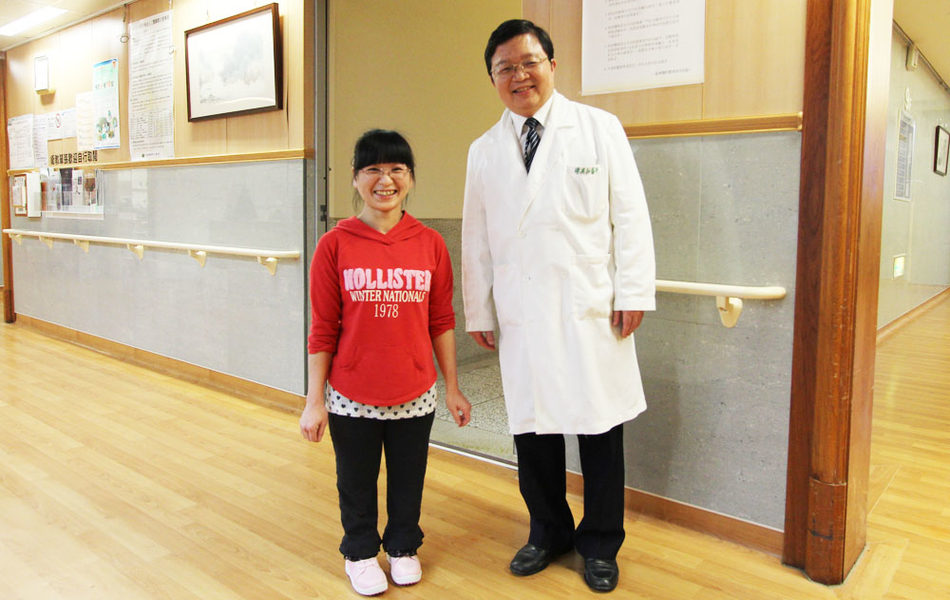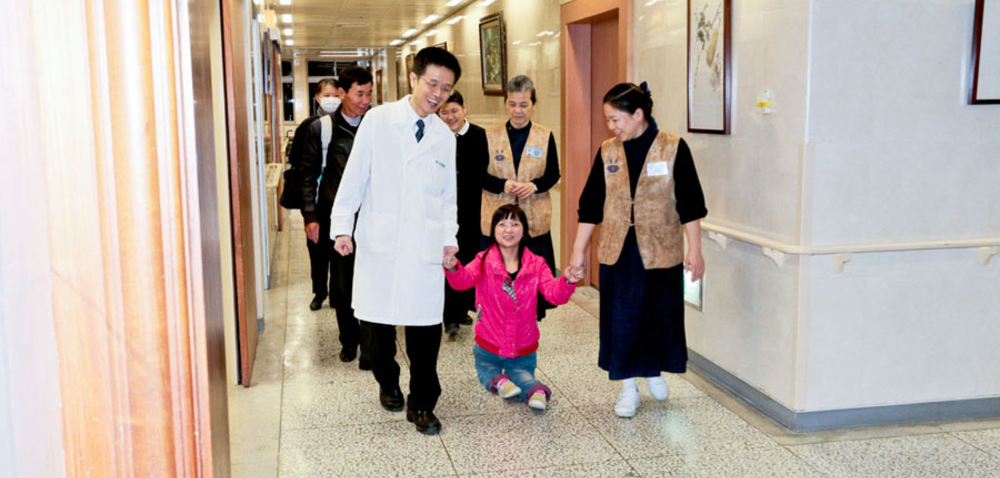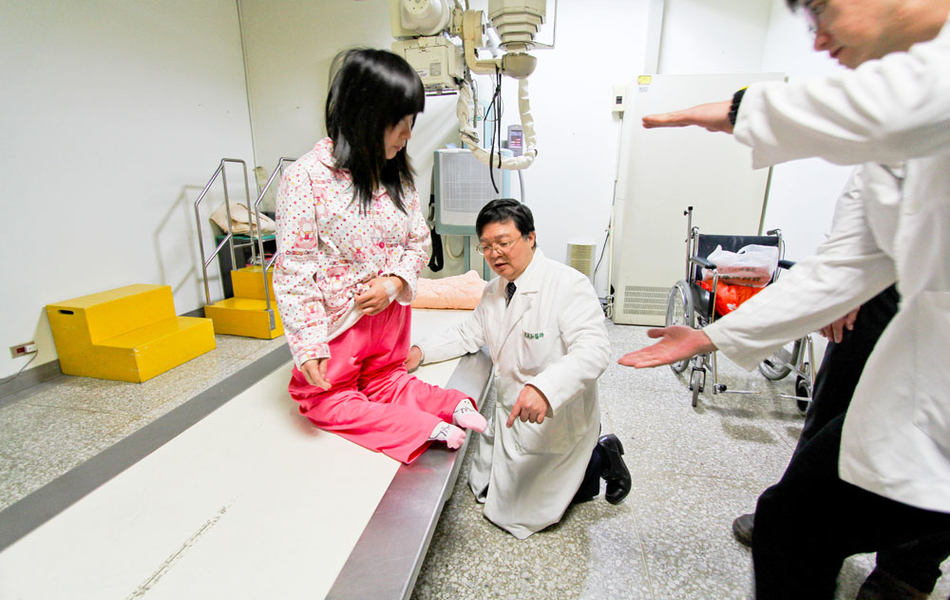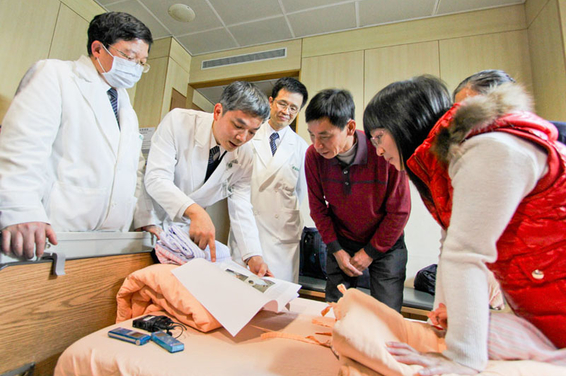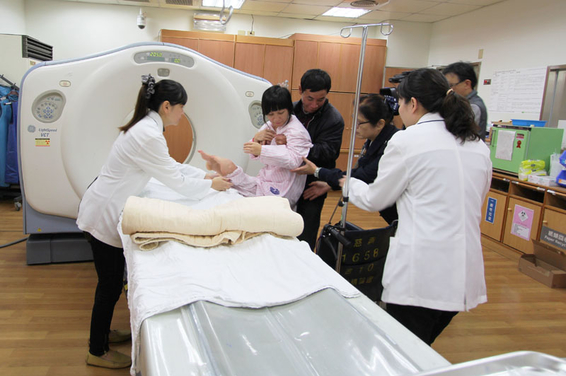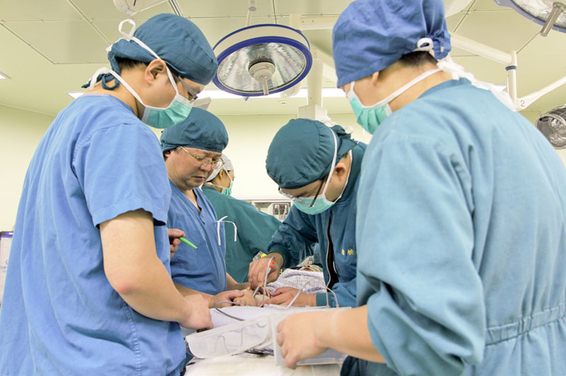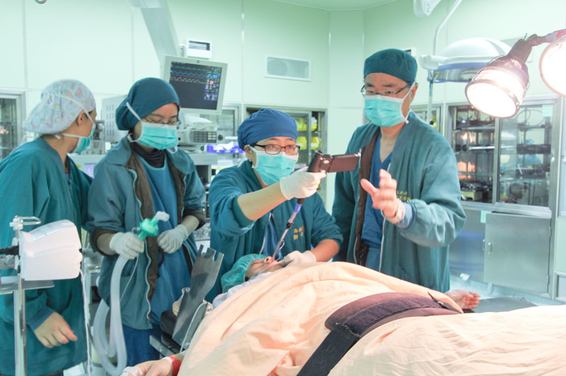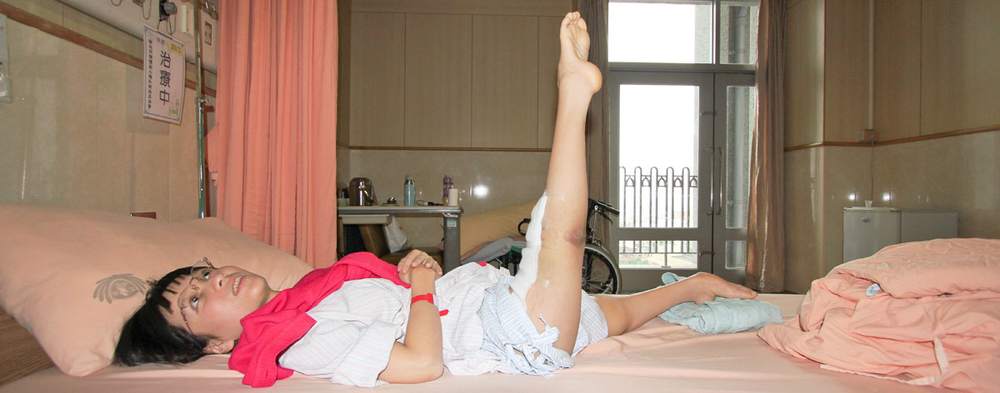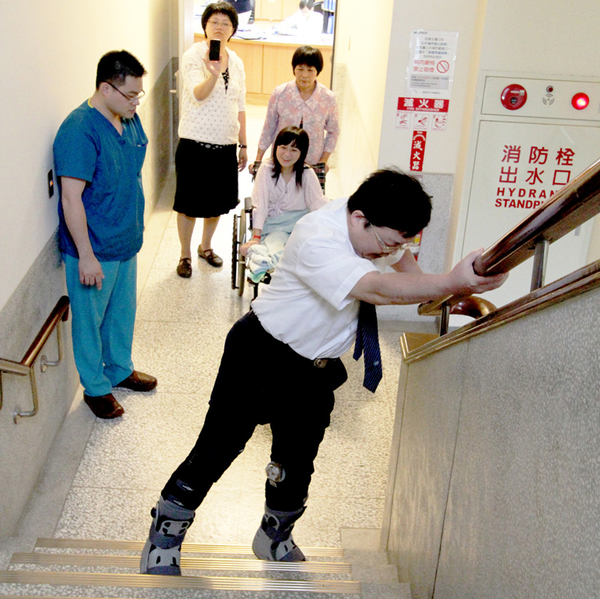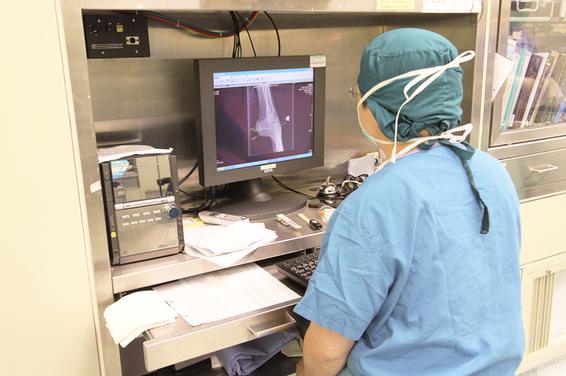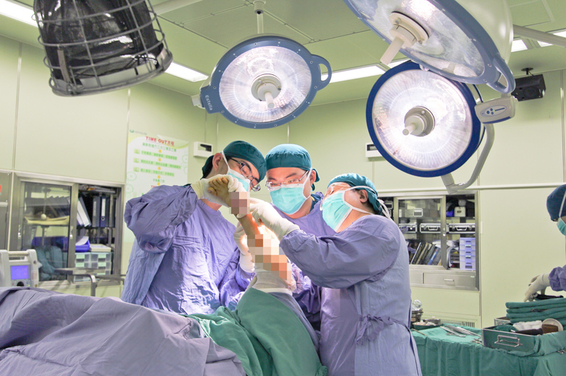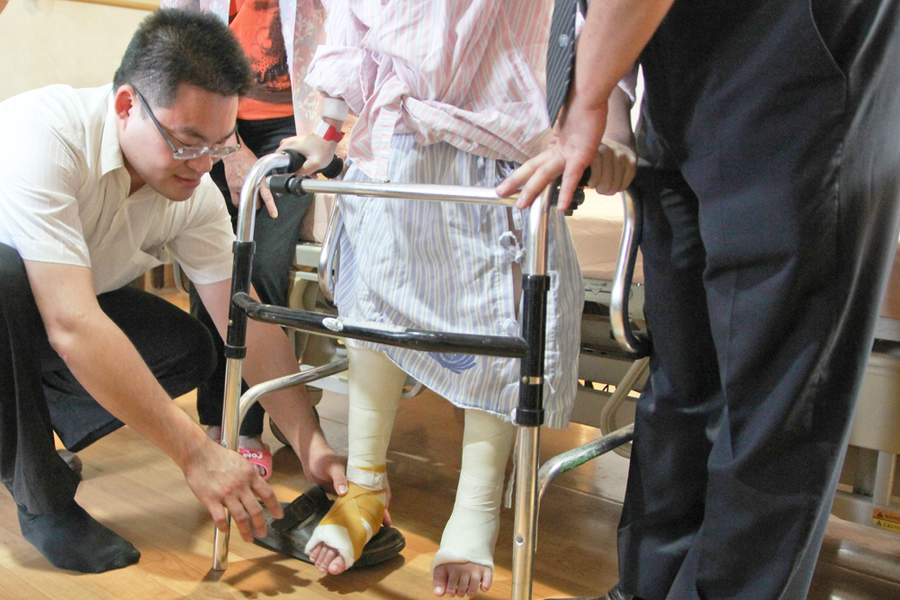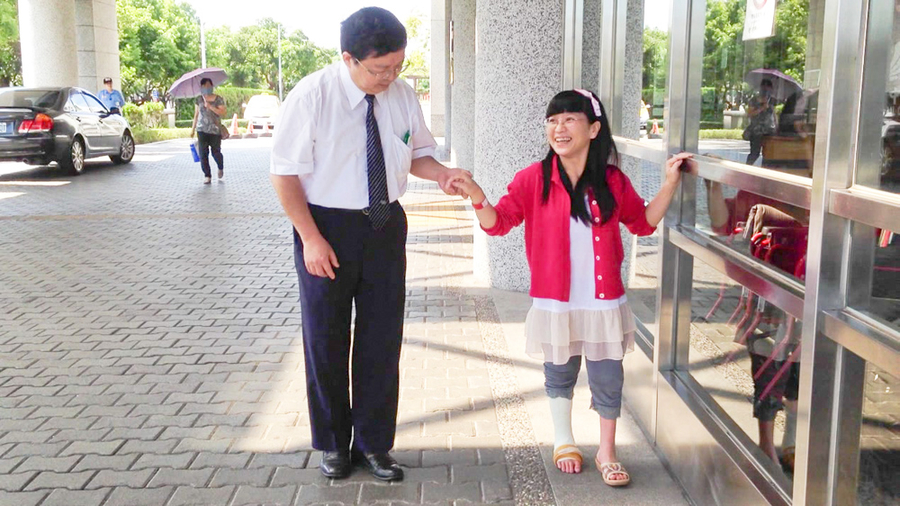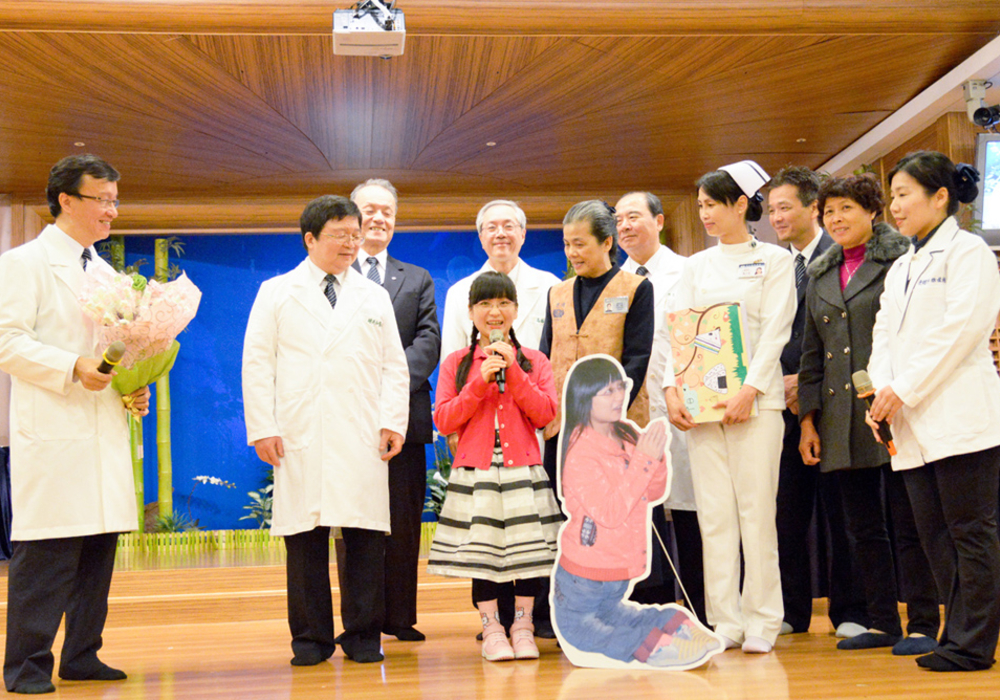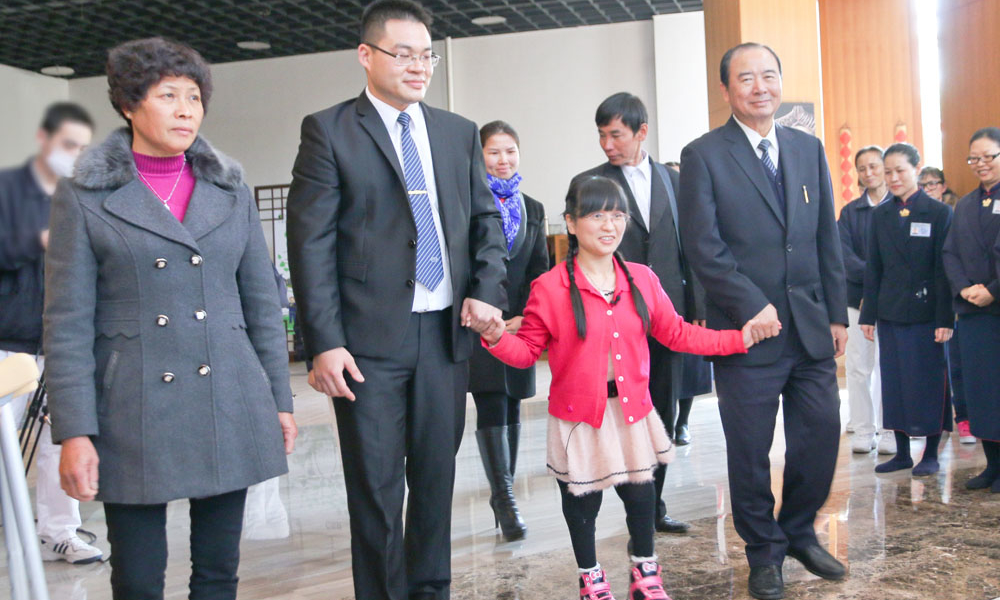A treatment of severe congenital knee hyperextension
By Huang Ssu-Chi, Peng Wei-Yun, Wei Wei-Ting
L-shaped girl, dreamed of wearing skirts, stand straight, walking.
L-shaped girl, always bright with smiles, ready for challenges.
Chen Tuanzhi, a girl with severe congenital genu recurvatum,
was born with her legs bending forward at the knee joints.
For 26 years, she could only walk on her knee pits.
In the face of a severe rare disease,
Orthopedic surgeon Chen Ing-Ho,
led the surgical team on an arduous mission.
After seven surgeries and painful rehabilitation,
Chen Tuanzhi could finally walk on her feet,
just like she did in her dreams.
“I have practiced medicine for three decades and never have I seen a rare case like this before,” said orthopedic surgeon Chen Ing-Ho, the honorary superintendent of Hualien Tzu Chi Hospital, as he met Chen Tuanzhi, the L-shaped girl from Xiamen, for the very first time. Chen Tuanzhi’s legs, instead of being straight, were bent at the knee to form a L-shape. This bizarre twist forced Chen to walk on her knees pits instead of her feet. Chen Ing-Ho contacted pediatrician Dr. Chu Shao-Yin to confirm the diagnosis, while pulling an all-nighter to read through all the Eastern and Western medical literature for prior examples. What Chen Tuanzhi had was extremely rare, as he found out, only two cases similar to her condition were ever reported worldwide. Furthermore, Chen Tuanzhi also suffered from secondary equinus foot deformity, with a severity that Chen Ing-Ho had never seen before.
Chen Tuanzhi and Father Chen Yurong, accompanied by Vice Supt. Chen Peir-Rong, Volunteer Yen Hui-Mei and Volunteer Chang Chi-Hsueh, arrived at Hualien Tzu Chi Hospital to prepare for surgical treatments.
The diagnosis was later confirmed by Dr. Chu to be severe genu recurvatum, or severe congenital knee hyperextension. Chen Ing-Ho hesitated at first on whether the patient could endure the risk and complexity of the correction. After listening to the optimistic Tuanzhi describing the hardships of her childhood, he knew the she was ready, and decided to take this seemingly impossible mission.
Chen Tuanzhi, born in Xiamen, China, was a cheerful young girl with a bright smile on her face. But her deformity at birth brought tears to her mother. The onlookers, at first gossiped only among themselves, then to her mother, encouraging her to wrap the girl up and dump her somewhere in the mountains. Tuanzhi’s mother and great grandmother looked down at Chen’s lively dark brown eyes, decided against their advice, and kept the girl.
Supt. Chen Ing-Ho examined the skeletal structure of Tuanzhi’s lower limbs while kneeling on the ground, a posture which he believed to be most comfortable for her.
On December 2013, with the collaborative effort of Xiamen Charity Federation and the Tzu Chi volunteers, Tuanzhi flew to Taiwan for the first time. Chen Ing-Ho organized a comprehensive diagnostic tests for her at Hualien Tzu Chi Hospital, and scheduled her surgical treatment the following March.
To receive this rare disease patient, Hualien Tzu Chi Hospital devised a comprehensive medical plan, as well as summoning a interdisciplinary meeting a day prior to surgery.
Strive for Independence
When Tuanzhi was born, her legs were deformed in a way that they rest on her shoulder. As she grew older, she managed to lower her legs more and more, but never to the extent of standing up straight. When she walked, she had to place her weight on her knee pits. Soon after birth, Chen’s parents took her to a local hospital for examination. The doctor warned them that Tuanzhi was too young to risk a surgery. Chen’s parents brought her back to the doctor when she was 10, only to be informed by another doctor that she was too old to receive any treatments. The diagnosis certainly came as a disappointment to Tuanzhi’s family. Coupled with the ongoing financial burden, they eventually forfeited the idea of seeking treatment.
After CT scan, X-ray and angiography examination, Supt. Chen Ing-Ho, Rehabilitation Department Dir. Liang ChungChao, Pediatrician Chu Shao-Yin and Vice Supt. Chen Peir-Rong arrived at the ward to explain the result and surgical treatment plans to Chen Tuanzhi and her family.
Concerned with Tuanzhi traveling to school alone, her parents decided to delay her entry for a year, so she could attend school with her little sister. From elementary to junior high, Tuanzhi’s litter sister took care of her every need. “I will never forget for all the things my sister had done for me. I owed her so much. Because of me, she never had time to play with her classmates, or to do whatever she wanted…” Tuanzhi said with teary eyes.
Tuanzhi was afraid of the odd gazes from her classmates, but nevertheless, she endured the fear and completed junior high with her L-shaped body. Out of aspiration for independence, Chen worked away from home. She participated in voluntary services during off-hours out of the goodness in her. Soon the local leaders noticed this extraordinary young girl and introduced her to Pan Shijian, the vice-chairman of The Chinese People’s Political Consultative Conference Xiamen Committee, who then introduced her to Tzu Chi Foundation.
Yang Xiaodong, who’s spine was bent forward over 200 degrees due to severe ankylosing spondylitis, could walk home with his head up high after half year of treatment at Hualien Tzu Chi Hospital. His success story soon spread throughout Xiamen. On Oct. 29, 2013, the day when Tzu Chi volunteers and Orthopedic surgeon Liu Kuan-Lin accompanied Yang back to Xiamen, Vice-chairman Pan invited the surgical team to visit Tuanzhi at her residence. When Dr. Liu realized that the only medical report of Tuanzhi was from eight years ago, he recommended her to visit Hualien Tzu Chi Hospital for a comprehensive examination.
With the monetary support of the locals, on Dec. 22, 2013, Tuanzhi flew to Hualien with family and Xiamen Tzu Chi volunteers. After a joint consultation of multiple departments and a series of medical examinations, Supt. Chen IngHo explained to her that, as rare as congenital knee hyperextension may be, the team would do all they could to treat her condition.
Listening to the treatment plan, Tuanzhi felt a ray of hope shone through the gloomy sky. “Although I do not know how the surgery will turn out, but I really want to stand. I have so many dreams to accomplish!” Chen said as she burst into tears.
Individualized Treatment Plan
There are totally four joints to be treated, two on both knees for the recurvatum deformity and two on both feet for the equinus foot deformity.
On the mor ning of March 12, 2014, Supt. Chen Ing-Ho made the first incision for Tuanzhi’s right knee corrective osteotomy. Facing the complicated correction operation, he performed several simulations prior to actual surgery. He went as far as drawing a surgical diagram of Tuanzhi’s bone size, scaled one-toone, so that the surgical team could clear grasp of every surgical procedure. “To an orthopedic surgeon, if you can draw it, you can operate on it,” he explained.
Bone removal, correction and implantation are the three major steps of corrective osteotomy. The surgery itself is divided into two stages. In stage one, closed-wedge osteotomy, a 4cm triangular shaped bone is removed from the femur, close the defect and the femur then achieves a correction of 80 degrees. In stage two, open osteotomy, the removed bone is shattered and then inserted into the opposite direction of the original gap to achieve another correction of 50 degrees. The combination of both phases can achieve a total correction of 130 degrees, which corrects the deformity in Tuanzhi’s leg and allows her to stretch both of her upper and lower legs in a straight line.
Chen Tsung-Ying (First Right), the director of the anesthetic department and the vice superintendent of Hualien Tzu Chi Hospital, led Dr. Cheng Wei-Chun (Second Right) to anesthetize Chen Tuanzhi, and the ensure that her trachea is not compressed.
During the surgery, the anesthesia team, led by Vice Supt. Chen TsungIng, monitored Tuanzhi’s vital signs and consciousness. Considering that she had to stay conscious once the operation was finished while she was still in the operation room to effectively evaluate postoperative nerve functions of her leg, the team used target-control infusion anesthesia, where a syringe pump was used to precisely manipulate the anesthetic dose administered according to the surgical condition and the patient’s requirement. In contrast to inhaled anesthetics, targetcontrol infusion anesthesia allows patients to recover consciousness faster with reduced agitation, as if they are simply waking up from a deep slumber.
The surgery was completed in three hours, achieving the expected goal of 130 degrees correction. After the surgery, Supt. Chen Ing-Ho inserted a needle into Tuanzhi’s thumb on her right leg to observe the bleeding. It was done to ensure that the postoperative blood circulation remains normal and unaffected. Then, it was time to identify what everyone was so concerned of - the nerve conditions of Tuanzhi’s lower limbs.
Tuanzhi’s nerves and blood vessels had been in a deformed state for a long duration, any displacement of the bone during the surgery could have an adverse impact, said Supt. Chen. It was vital for Tuanzhi’s to regain consciousness in the operating room to confirm her neurological status.
The medical staff in the operating room awaited in silence for twenty minutes for Tuanzhi to regain consciousness. “Tuanzhi is awake!” Vice Supt. Chen Tsung-Ing finally broke the silence. Supt. Chen Ing-Ho immediately began testing Tuanzhi’s neurological status.
“It’s moving! Tuanzhi’s toes are moving!” He shouted out in excitement. The entire medical staff smiled in relief.
Dr. Liu Kuan-Lin monitored the blood flow in Tuanzhi’s right leg and reconfirmed that everything functioned normally. The first surgery of the corrective osteotomy was a success.
“Tuanzhi’s legs are straight! Supt. Chen, thank you so much!” said Tuanzhi’s mother as tears watered her eyes. Volunteer Yen Hui-Mei offered her some homemade red bean soup. Xiamen Tzu Chi Volunteer Ke Chunxia also proposed to sleep in the ward and attend to Tuanzhi, so both the mother and the daughter could have a good night rest.
To Sleep on Her Back
The first thing Tuanzhi did in the morning following the operation was to took a selfie and shared her progress with friends. Physical Therapist Hsu Chia-Li had planned a series of physical rehabilitation to strengthen Tuanzhi’s muscle and to loosen her tendons. Five days since the operation, Tuanzhi, for the first time, left the hospital bed and sat on a wheelchair customized for her. “It feels great to stretch my legs!” She said with a smile. She was so thrilled that she grabbed her mother and Volunteer Ke Chunxia for a walk under the Hualien sun.
After two surgeries and long, hard rehabilitation, not only could Tuanzhi stretch both of her legs straight, she could left them up in a 90 degrees angle.
The second operation was scheduled on March 22. Despite having a successful first operation, the surgical team remained vigilant. Because the deformity in the left knee was worse than the right knee, the aim was a correction of 160 degrees.
Supt. Chen wore the pneumatic ankle brace and hinged knee brace to simulate Chen Tuanzhi's walking posture after the surgery. He walked up and down the stairs as a live demonstration.
Considering the resistance of the body tissue and the safety of neurovascular bundles, Supt. Chen Ing-Ho further divided the correction into two stages to minimize the stress on the patient. Fortunately, the first stage was successful, with a correction of 130 degrees, 80% of the target goal, and the neurovascular functions in the left leg remained intact.
Two weeks later, on April 4, Tuanzhi’s received her third operation, correcting the remaining 30 degrees deformity in her left knee. The soft tissues near the surgical site had adapted to the new angle, which allowed the third operation to proceed smoothly.
“It feels so different! I can know sleep on my back, cover the blanket up to my chest, and I can turn over and prone whenever I like!” Said Tuanzhi excitedly. In the past, she could only sleep on her sides.
Hard Solid Rehabilitation
April 9 was Tuanzhi’s 26th birthday. The Tzu Chi volunteers baked a birthday cake and, together with the surgical team, celebrated her birthday, leaving Tuanzhi pleasantly surprised.
In 2008, Tuanzhi’s uncle opened her eyes to the world by teaching her to use a computer; in 2013, she became acquainted with Tzu Chi; and in 2014, she flew to Taiwan to receive treatment that changed her life around.
Tuanzhi’s 26th birthday was a pivotal point in her life, as it marked the year of her rebirth.
The fourth surgery was performed with Dr. Liu Kuan-Lin and Dr. Chu Chun-Hua holding Chen Tuanzhi’s right leg in mid air. When performing closed corrective osteotomy, it is best for the patient to lie on her back. Hence, when lengthening the ligament, one of the patient’s legs must be held in mid air throughout the surgery.
The inequality in length of Chen Tuanzhi’s legs created unevenness when she practiced standing. Orthopedic surgeon Liu Kuan-Lin took off his shoes so she could stand on it to offset the unevenness. With the help of Supt. Chen Ing-Ho, Chen Tuanzhi practiced standing for the first time.
Prior to the first surgery, Supt. Chen Ing-Ho spoke to Tuanzhi regarding her prognosis. The expected activity level of the knee and ankle joints after the surgery would be only one-third that of a normal joint, and even with that degree of recovery, she still could not walk like a normal person. To illustrate his point, Supt. Chen Ing-Ho wore a pneumatic ankle brace and a hinged knee brace to simulate how Tuanzhi would walk and climb after the surgery. He also gave her a series of rehabilitation as homework that she could practice at her own time.
“Step! Kick! Step! Kick!” Instructed Chia-Li, Tuanzhi’s phsyical therapist. Tuanzhi sat on walker, exerting herself with every step, repeatedly. She did not complain about the pain or the fatigue. The only thought on her mind was to rehabilitate properly, so she could walk home.
Correct the Equinus Foot Deformity
The surgical treatment advanced into its second phase - the correction of the feet. When normal people walk, their footplate is flat against the ground. Tuanzhi’s equinus feet, on the other hand, were at a right angle to that of a normal person’s feet. Without correction, it would be impossible for her to stand and walk.
Supt. Chen Ing-Ho performed the fourth and fifth surgeries on April 30 and May 14 respectively, completing the correction of left and right foot. The challenge was, as he pointed out, to correct the footplate from being perpendicular to the ground, to being parallel to the ground. To accomplish that, they would have to remove a larger section of the foot bone and lengthen the Achilles tendon. Both are complicated and risky surgeries, however. Complications such as skin necrosis and ulcers are particularly troublesome.
Another concern of foot surgery is its uncertainty. A cast would be plastered around the foot after the surgery for two to three months. One can walk while wearing the cast, albeit with certain inconveniences. But once the cast is removed, whether or not the injured foot can endure walking without the support of the cast remains to be seen. We cannot foresee the speed of bone healing of her foot.
Fortunately, all five major surgeries proceeded smoothly. Although plastered in cast, Tuanzhi could practice standing and walking with her foot. Her hyperextended legs could be straightened and feet flattened. It was time for vigorous rehabilitation and physical training.
A Dream Come True
With the help of Supt. Chen Ing-Ho, Chen Tuanzhi practiced standing for the first time.
July 1 was a big day for Tuanzhi. After five surgeries and a month of intense rehabilitation, finally she could, with a walking aid, take her first proper step in life. “This is the first time ever since I was born to walk on my feet. Having both of my feet flat on the ground is like a dream come true!” She said happily.
With the help of walking aid, Tuanzhi took each step slowly, but surely. A distance of two meters may not pose a challenge to a health individual, but to her, a patient with congenital knee hyperextension, it was a astonishing feat. Her physical therapist stood behind her, keeping just a step away, shielding Tuanzhi with her own body in case Tuanzhi lost her footing.
Su Xuan, who frowned whenever she saw her daughter rehabilitate in pain, finally smiled. “I watched Tuanzhi improve day by day, and now I see her walking. It is incredible!” Su Xuan smiled.
Hundred Days of Waiting
On Aug 8, Supt. Chen removed the cast from Tuanzhi’s right leg. Without the restraint, she was able to move her leg freely. “With the cast gone, my leg feels so light,” said Tuanzhi.
Tuanzhi’s father, Chen Yurong, had not seen his daughter for four months straight. When he flew from Xiamen to Hualien, the joy on his face was pronounced. Tuanzhi could not wait to demonstrate the rewarding achievement of her rehabilitation. Chen Yurong knelt down before her, ran his fingers over her legs and toes that were once severely deformed. “I cannot believe my eyes. It is truly a miracle!” He exclaimed.
2015.1.21 The surgical team assembled by Hualien Tzu Chi Hospital held a farewell press conference for Chen Tuanzhi. From Left: Medical Secretary Li Yi, Honorary Supt. Chen Ing-Ho, Medical Mission CEO Lin Chin-Lon, Chen Tuanzhi, Supt. Kao Ruey-Ho, Volunteer Yen Hui-Mei, Vice Supt. Hsu Wen-Lin, Head Nurse Chen Yu-Chuan, Chief Secretary Chen Hsing-Chu, Tuanzhi’s Mother Su Xuan, and Physical Therapist Hsu Chia-Li.
Reinforce the Right Knee and Right Foot
The corrective osteotomy that Tuanzhi received were complicated surgical operations with high degrees of correction. More often than not, the patient received what was considered to be an adequate amount of correction in surgery, only to realize that it was insufficient when the patient actually started walking. This was exactly what occurred to Tuanzhi.
When everyone was ecstatic for Tuanzhi when she managed to walk few dozen meters with only the aid of a walker, Supt. Chen Ing-Ho was pondering on something else. He had realized that, from Tuanzhi’s walking posture, that further corrections were required. Without them, even if Tuanzhi was able to stand and walk, the outcome would not be as ideal. Furthermore, the faultiness one would impact the other three joints, meaning that for Tuanzhi to walk ideally, all four joints must be in its best possible condition.
When Supt. Chen Ing-Ho proposed another surgery, Tuanzhi agreed without any hesitation, knowing full well that she had to undergo the entire surgical procedures again, including the inconveniences of casting.
On Aug. 19, Tuanzhi received her sixth surgery. Her right knee was further corrected by 30 degrees, and with improved tightness to support the leg as she stands and increased joint activity when she walks.
On Sept. 3, Tuanzhi received her seventh and final surgery, where her right ankle was further corrected by 30 degrees to enhance the flatness of the footplate against the ground.
Jan. 22, 2015. Chen Tuanzhi got back to Xiamen, with families and friends greeting her. Photo depicts Hualien Tzu Chi Hospital vice supt. Hsu WenLin (right) and Orthopedics Dr. Liu Kuan-Lin(left ) leading Tuanzhi to the greeting party.
New Pair of Shoes
In the ten-month long treatment, the surgical team, led by Supt. Chen IngHo, innovatively integrated close and open corrective osteotomies and treated Tuanzhi’s knees and feet respectively. Each knee received 160 degrees of correction from the osteotomy. Each foot underwent corrective osteotomy, Achilles tendon Z-lengthening, and tendon allograft reinforcement to receive 90 degrees of correction. Tendon allograft, amid other surgeries, was only made possible because of a selfless donor who donated his tendon tissues, which is unique in this hospital.
The surgery was divided into seven stages to straighten the legs, to provide the joint strength, to preserve the joint flexibility, as well as to maintain the length of her lower limbs. Originally 93cm tall, she became 128cm tall after the surgery. From tetrapod walking stick to a crutch, she could finally stand with her own strength. The miraculous improvement brought a smile on Supt. Chen Ing-Ho’s face.
“Tuanzhi’s surgical treatment has come to an end,” said Supt. Chen IngHo. “It is time for intense rehabilitation.” 26 years of deformity had caused a disproportion growth in Tuanzhi’s lower extremities, where the left leg was shorter than the right by 2cm. To be able to stand and walk properly, she would need special shoes as walking aid. No one knew her condition better than Supt. Chen IngHo, so he personally picked the pair that would satisfy her needs.
Considering Tuanzhi is a girl, he chose a pair with bears and hearts that looked like a high heel. She fell in love with her present at first glance. “I am so happy to wear the shoes Papa Chen bought for me!” She laughed.
Time to Walk Home
The surgeries were distressing, and so was the rehabilitation. Chen Tuanzhi managed to pull through either with her incredible optimism. With the new pair of legs, she took each step with resolution and gratitude. On Jan. 22, 2015, she returned to Xiamen with the blessing of the surgical team and the Tzu Chi volunteers.
With the new “height” comes new obstacles. The surgical team reminded Tuanzhi that when she returned home, she would have to readapt to the environment she once accustomed to, according to the new height she had gained from the surgery. But to Tuanzhi, it was the least of her concerns. She was ready to face any obstacles that life throws at her. She was ready to live her life.

